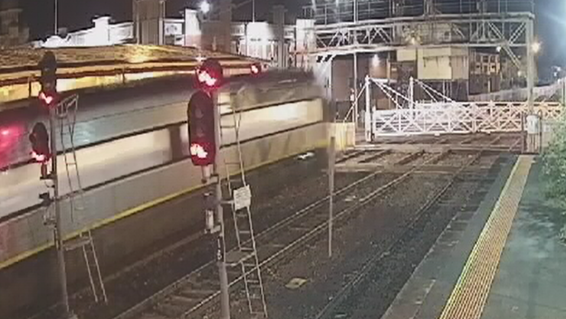
|
Key points
|
A Vlocity passenger train’s sanding system was ineffective in improving wheel-rail adhesion as the train approached Ballarat Station on the evening of 30 May 2020 after light rain and in windy conditions, a transport safety investigation details.
The three-car V/Line Vlocity train was operating a service from Melbourne to Ballarat and Wendouree when, unable to stop at Ballarat Station, the train collided with the Lydiard Street North level crossing gates, which were closed to rail traffic, according to the investigation by Victoria’s Chief Investigator, Transport Safety (who conducts rail investigation in Victoria on behalf of the Australian Transport Safety Bureau).
“Slippery rail conditions existed for at least the final 2.5 km of the approach to Ballarat Railway Station and probably the final 5 km,” said Chief Investigator, Transport Safety Mark Smallwood.
“Light rain was the primary environmental factor in the development of the slippery conditions, and the very low levels of adhesion at the contact between the train’s wheels and the rail head substantially reduced the train’s braking performance.”
The driver made initial brake applications approximately 5.1 km from Ballarat Station when the train was travelling at just over 160 km/h, and made a full service brake application about 2.6 km from the intended stopping point. However, the train did not decelerate sufficiently and could not be stopped, the report details.
The train passed through the station and collided with the level crossing gates at an estimated speed of between 93 and 97 km/h. After impacting the gates, the driver subsequently brought the train to a stand approximately 640 m beyond the station.
One of the two passengers on board required hospitalisation, and the train driver and conductor sustained minor injuries. The impact destroyed the pair of southern gates, damaged the front and side of the train, and resulted in gate debris being scattered into the surrounding area.
“The investigation found that the train’s sanding system, which is intended to improve adhesion in slippery conditions by applying sand to the rail head, was ineffective at improving braking performance,” said Mr Smallwood.
Reviewing the train’s data logger, investigators established that the train’s wheel slip/side protection (WSP) and sanding systems both automatically activated during the approach to Ballarat Station.
“Several factors potentially adversely influenced the performance of the sanders that evening, including their design configuration, vegetation contamination in one sander box, and the lack of sand in a second,” said Mr Smallwood.
“There were missed opportunities to identify weaknesses in the sander configuration, while maintenance of the sander units did not test for discharge flow rates, and train preparation processes did not ensure a required minimum amount of sand in the sand boxes.”
Mr Smallwood noted that since the incident V/Line has implemented a number of measures to improve sander performance, and has installed sanders on the intermediate cars of three-car VLocity diesel multiple unit sets.
The investigation also found that safety controls were ineffective in mitigating against a train arriving at Ballarat Railway Station travelling at excessive speed and being unable to stop before colliding with the crossing gates.
To enhance management of this risk, V/Line has introduced a number of interim measures including reducing the permitted train speed on the approaches to Ballarat Station from 160 to 80 km/h, and installing overspeed-triggered operation of the Lydiard Street North level crossing protection.
“This occurrence has highlighted the importance of rail operators having risk controls in place to prevent collisions because of slippery rail conditions,” Mr Smallwood said.
“Controls include effective train-borne equipment such as wheel slip/slide protection systems and sanders, and targeted risk controls at locations vulnerable to risks associated with train overrun.”
Read the report: Collision of passenger train 8185 with level crossing gates, Lydiard Street North, Ballarat, Victoria, on 30 May 2020


